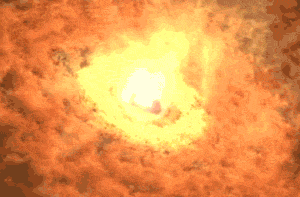Sun and the Elements
Sun and the Elements
Space | Cosmology | Astrophysics | Gravity | Sun | Black-Hole | Universe | Solar-System | Moon | Celestial-Bodies | Star | Planets | Saturn
Will the Sun die?
Elements (e.g. Hydrogen, Copper) cannot be manufactured by any means. Elements can be combined to form Compounds (i.e. adding two or more elements e.g. 2 hydrogen + oxygen= water.)
Here the question is: HOW WERE THESE ELEMENTS FORMED? THE BIG BANG The Big Bang- As they say occurred around 13.7 Billion years ago, it just formed 2 of the lightest elements which are, HYDROGEN and HELIUM.
As the universe was expanding, gravity was acting on hydrogen which made it come close together. As they came close, the particle started to move fast under the influence of gravity Travelling fast produced more energy and increase in the temperature, resulting it to turn to plasma.
It had loads of energy in its electrons hence it escaped from the atom. However hydrogen just left the proton behind. This week interaction converted the proton into neutron. Protons and Neutrons are made up of QUARKS.
Since gravity is still acting on them, the protons and neutrons are pushed together by going through various processes. 2 protons and 2 neutrons end up as the nucleus of the HELIUM element. Usually this is not possible for 2 protons to get closer as like charge repel each other because of the Electrostatic or Coulomb force of repulsion. As the temperature is extremely hot, the particle has sufficient energy to overcome the Coulomb Repulsion force and fuse together.
This process is said to be FUSION. The hydrogen is now a STAR. This process of hydrogen converting to helium releases energy. The reason behind this is; the mass of 2 protons and 2 neutrons is greater than the nucleus of helium. Here the mass difference is converted into energy by Einstein's famous equation: E=MC^2.
A huge amount of hydrogen is converted into helium therefore huge amount of energy is released in the form of light and heat. This energy creates pressure. The pressure created is enough to balance the gravitational force which is trying to collapse the star further. While the fusion process is working, the gravity is held at bay, and the star maintains its size. For most stars it happens to be for the entire duration of their life. For e.g.
The Sun is said to be 5 Billion years old, and is expected to live for more 5 Billion years. Throughout this time it is steadily converting hydrogen to helium. Assuming at some point all of hydrogen is converted into helium, now what? The outer layer still contains substantial amount of hydrogen, but the main fusion process which was holding gravity in the core of a star will stop.
Once this process stops, gravity takes over and the star becomes to contract to the core. As it contracts the temperature increases. This energy is sufficient to fuse with the higher elements of The periodic table. It can go up to IRON (26) [depending how big the star is]
That is:
Hydrogen to Iron.
In each case the mass of the nucleus of the element formed is smaller than the nuclei used to make it. e.g. B is formed through A The mass of the nucleus of B is smaller than of A. In simple words mass of A is greater than B.






Very well written blog...
ReplyDeletegood job...very well explained
You may also visit my blog by clicking below..
Wings of fire
Interesting article. The universe is fascinating!
ReplyDeleteVery Good.
ReplyDelete